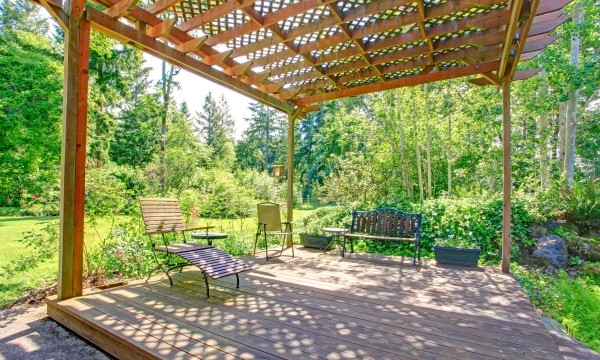Gardeners have used arches, arbours and pergolas to add interest and height to gardens since the time of the Romans.
- Browse Categories
- All Tips
-
Home & Garden
- All
- Appliances
- Bathroom
- Cleaning
- Crafts
- Decorating
- Electrical
- Flooring
- Furniture
- Garage Door
- Gardening
- Green Living
- Heating
- Home Alarm Systems
- Home Maintenance
- Home Remedies
- Home Security
- Home Staging
- House Sitting
- Junk Removal
- Kitchen
- Lawn Care
- Lock Systems
- Moving
- Outdoor Living
- Pest Control
- Plumbing
- Renovation
- Roofing
- Snow Removal
- Storage
- Tools
- Tree Service
- Health
- Family
- Travel
- Auto
- More Tips

Add a unique element to your garden with an arbour or pergola
June 30, 2015

Arbours and pergolas
Now available in either modern materials or traditional wood, they enhance gardens of any size or design and serve every type of climbing plant.
- A pergola is an arbour that you walk through or sit beneath.
- It can be a simple, open frame or a series of arches that create a tunnel effect.
- A pergola should have a focus — it can be a destination, showcase a view or create a stopping point along a garden path.
Before building
Before building any large garden structure check with your municipality to make sure you'll be complying with local zoning codes and building regulations before you invest your time and money.
Placement is key
Tucked away in a secluded nook and sheltered by fragrant flowering vines, an arbour becomes a romantic hideaway.
- It can accent a garden, offer an inviting destination or command an imposing view.
- Arbours provide shade in summer and year-round screens to hide garden work areas.
Consider perspective
The arch of a pergola, inviting you to pass underneath, has the effect of dividing a garden in two.
- If you have a small garden, a pergola may make it seem larger, particularly if you position it so that it hints at wider vistas beyond.
- On the other hand, a pergola will make a long garden appear shorter.
Choose the right colour
- In a small garden, choose an arbour or pergola with a slim framework or one that's painted green to blend in with the background.
- In a large garden, you can afford to draw attention to the pergola's structure or colour.
Design in proportion
Design in proportion to the plantings your arbour will support.
- Anticipate the size of mature vines and climbers.
- Delicate latticework can't support mature wisteria, while heavy timbers will dwarf fragile clematis.
The best woods
- The best woods for arbours and pergolas are redwood, cedar, cypress, teak, oak and locust.
Pressure-treated lumber is an inexpensive alternative that's useful when lumber must be in contact with soil. It tends to bow and split, however, and doesn't take stain well.
Use rust-resistent fasteners
- Use rust-resistant fasteners made of brass, bronze, hot-dipped galvanized steel or stainless steel.
If your local hardware store doesn't stock these, try a marine supply store. Always predrill holes for nails, bolts and screws to avoid splitting the wood.
Use waterproof glue
- Use waterproof glue on joints where extra strength is required.
- Epoxy glues are extremely strong and will accept stain well; they're available at woodworking and marine supply stores.
Paint problems
After a few seasons, paint chips, blisters and peels, so the structure will need to be scraped, sanded, primed and repainted.
- White or green is traditional for arbours, or duplicate the colour of the trim on your house to create a unifying link.
- Stains are easier to apply than paint, they protect the wood and they never blister or peel.
- For colour, pigmented stains are a good substitute for paint and come in a wide assortment of tints.
Pave beneath your arbour
- Pave the area beneath your arbour with brick, flagstone or gravel if the arbor casts dense shade.
Grass can't survive without sunlight.
Add lattice panels
Add lattice panels to your arbour to serve as trellis screens.
- Traditional arbour plants include clematis, jasmine, wisteria, climbing roses, ivy and, of course, grapes — a longtime favourite.
- Or hang baskets of flowering plants that add fragrance and splashes of colour.







